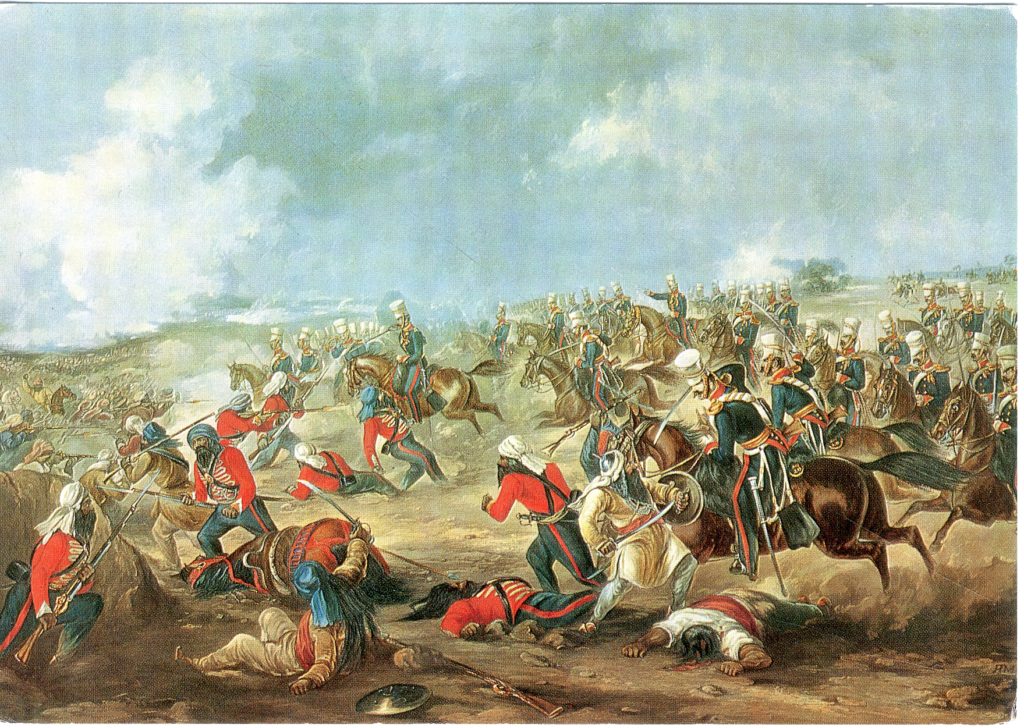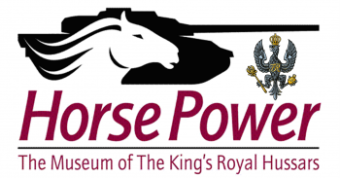Brigadier-General Charles Robert Cureton
One of the 'Heroes of Ramnuggur'
For the 175th anniversary of the Battle of Ramnuggur [Ramnagar] we have been looking at the incredible life of Brigadier-General Charles Robert Cureton, the highest ranking casualty of the battle, and a soldier whose links with the 14th Light Dragoons began almost forty years before the battle!
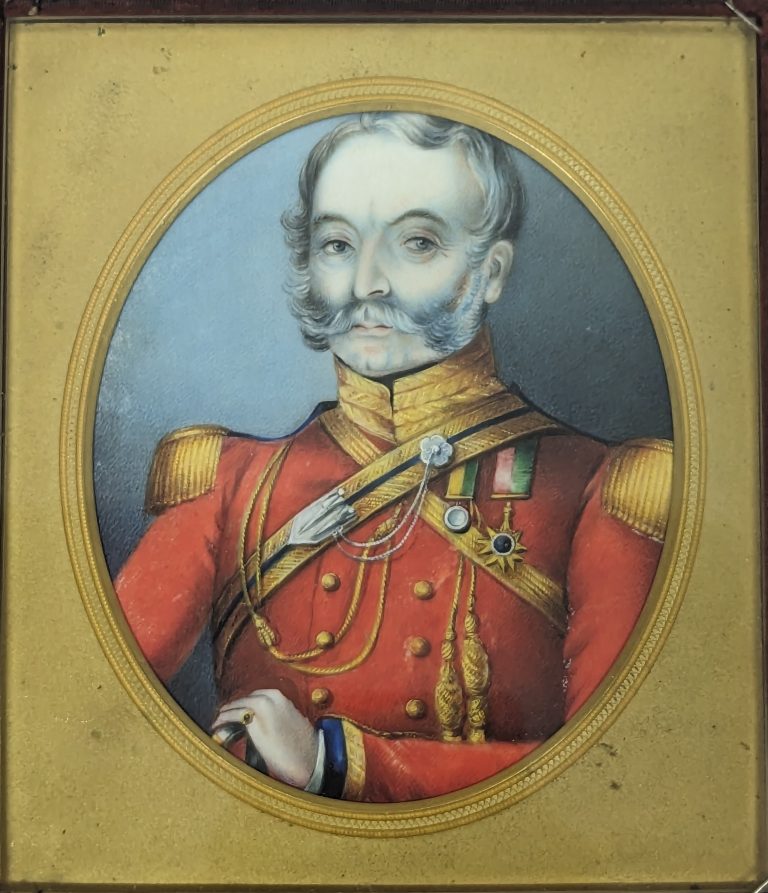
Charles Robert Cureton was born in 1789 to Edward and Henrietta Cureton. His father was a Shropshire gentleman and it was in the Shropshire Militia that Cureton was first commissioned as an Ensign around 1806.
There are variations in the details but most accounts of his early life suggest that ‘being popular, fond of society and with over-generous and hospitable impulses, he found himself in financial difficulties’. He is then said to have suddenly resigned his commission and disappeared before joining another Militia regiment. But his problems followed him and he once again had to ‘disappear’. Being threatened by creditors he left home and, having abandoned his clothes on a beach in a South Coast resort, it was assumed he had drowned while he actually made his way to London. Some sources add that that he disguised himself as a sailor for the journey.
it appears he did come to London and there enlisted as a Private in the 14th Light Dragoons around January 1809. Two names are given for the one he enlisted under, either the name ‘Charles Roberts’ or ‘Robert Taylor’. In his recollections of the Peninsular War General Thomas Brotherton, then an officer in the regiment, stated that Cureton was a Corporal in his troop and served as Charles Roberts.
Cureton joined the 14th Light Dragoons in the Peninsula in 1810 and then served throughout the camapign. On 1 October 1810 he was wounded in the right leg by a rifle ball in crossing the Mondego near Colimbra. At the Battle of Fuentes de Oñoro on 5 May 1811 he received a sabre cut on the head which fractured his skull, and another on his left hand.
Of his time in the ranks of the 14th Light Dragoons there are a few scattered accounts from those he served with. Years later, in a letter certifying Cureton’s earlier services Lieutenant Colonel John Townsend wrote:
‘I was so fortunate to have you in my troop during the great part of that time and therefore can safely say that [in] your intelligence on outpost and gallantry in the field you were not surpassed by any man in any Regiment of service’.
In 1846, when Cureton had distinguished himself in the Sutlej Campaign, a letter was published in the Evening Mail of 15 April 1846 claiming to be from a former comrade of the 14th and read:
‘Sir – Having read several letters relative to that distinguished officer, Brigadier-General Cureton, formerly a private in the gallant corps of the 14th Light Dragoons, I am persuaded that you will do me the honour to insert these few lines, especially when I assure you they come from pen of an old trooper who has ridden with the gallant colonel in the same battlefield, bivouacked under the same bush, and with whom he has shared the contents of the same haversack…..
Private Charles Roberts (the name he enlisted under) joined the 14th Light Dragoons at Portalegre, in Portugal, with a remount from England under the command of the brave Major Fenton Hervey [Hervey had recovered from the loss of an arm at Oporto in the charge of the 12th May 1809]…
About the end of 1811, Private C. Roberts was appointed corporal in Captain Townsend’s troop. In 1813, the Light Dragoons lying at Hurte and its adjacent, Corporal Roberts was despatched on duty to St. Jean de Luz, about three leagues distant, to copy general orders, when he was recognised by an officer of the Duke of Wellington’s staff as an acquaintance…This staff officer waited upon Lieutenant Colonel Hervey at Hurte, to whom he related the particulars… Colonel Hervey having questioned Corporal Roberts in presence of his friend, was pleased to recommend him to the Duke of Wellington, when a few days afterwards he was ordered to proceed to St Jean de Luz, and was appointed serjeant of the post to the head-quarters of the army. In 1814, Sergeant Roberts Cureton received an ensigncy in the 40th Foot. The cavalry being his element, an exchange was effected for him into the 20th Light Dragoons….In conclusion, Sir, I beg to assure you that there are few, if any one, of his old comrades more gratified at the gallant colonel’s success that his comrade of the bivouack, nor can the most gifted pen add any honour that has not been achieved by the sword.
I beg, Sir, the honour to subscribe myself, Your obliged servant, An Old Trooper 14th (D.Y.O.) Light Dragoons.’

Other sources provide a slightly different version of events, but the London Gazette records that on 24 February 1814 Sergeant Charles Robert Cureton of the 14th Light Dragoons was commissioned as an Ensign in the 40th Regiment of Foot.
It is hoped that planned research will provide more accurate information, but the digitised Muster Roll of the regiment from Jan – March 1814 records Corporal Charles Cureton (his true name having been revealed) being promoted to Sergeant on 24 January 1814 and then on 23 February leaving on promotion to the 40th Foot. He may never have served with the 40th Foot in the field as it appears he served mainly on various staff duties, including at the Battle of Orthes, Tarbes and Toulouse.
On 20 October 1814 he exchanged into the 20th Light Dragoons where he remained until the unit was disbanded in 1818 and he was placed on half pay. In January 1819 he was restored to full pay as a Lieutenant in the 16th Light Dragoons (Lancers). With the 16th Lancers he was present at the Siege and capture of Bhurtpore in 1825-26 and in the Afghanistan Campaign of 1839-40 (First Anglo-Afghan War) where he served as Assistant Adjutant-General of Cavalry was present at the siege of Ghuznee and at the occupation of Kabul. At the conclusion of the campaign he was awarded the Order of the Durrani Empire (Third class) by Shah Shujah Durrani. He also fought in the Gwalior Campaign of 1843, commanding a brigade of cavalry and In 1844 he was appointed a Companion of the Order of the Bath (CB).
After two years in England, he returned to the 16th Lancers in India and distinguished himself during the Sutlej Campaign of 1845-1846 (the First Anglo-Sikh War), commanding the cavalry at the Battle of Aliwal and a brigade at Sobraon. As a result of his distinguished service he was appointed Aide-de- Camp to the Queen, with the rank of Colonel in the Army, and was also appointed Adjutant-General to the Queen’s forces in India.
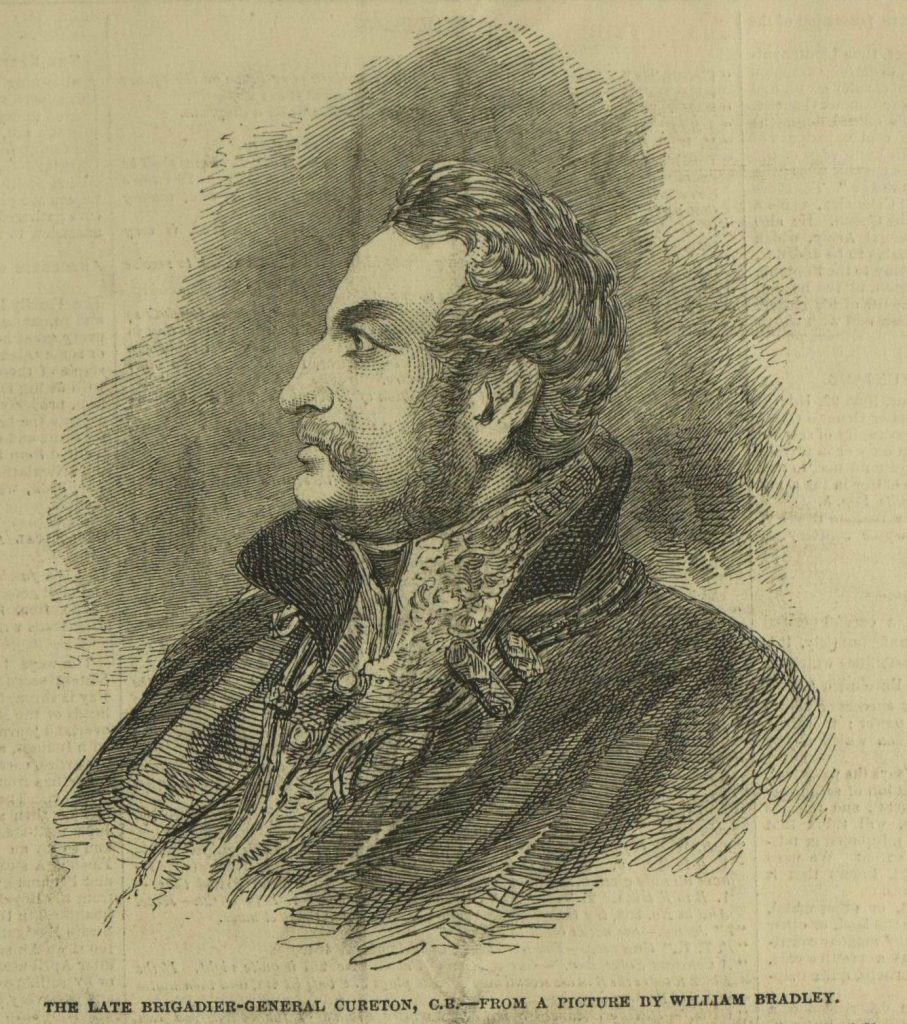
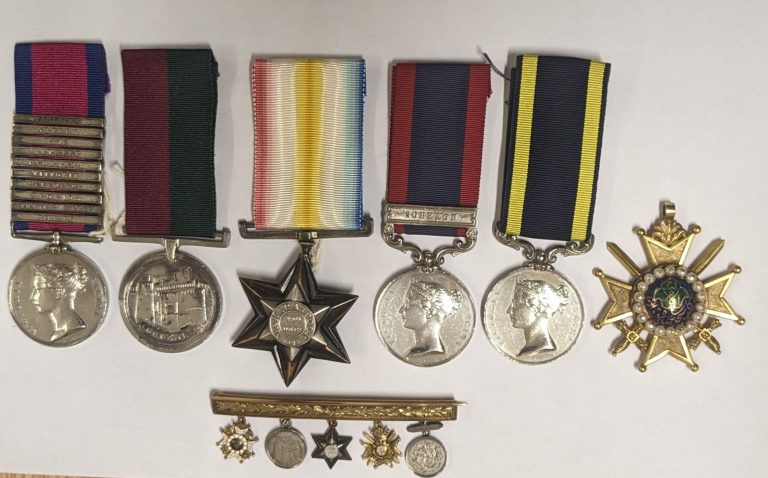
His extraordinary career is reflected by his medals, which are held by the Museum (except the CB). They are accompanied by a remarkable set of miniature medals, which are the CB, the Ghuznee Medal, the Maharajpoor Star and the Order of the Durrani Empire and an unknown medallion with a bar for ‘Sobraon’. It is not the Sutlej Medal and may represent an individual award. Curiously the centres of the CB and the Order of the Dooranee Empire have been transposed and are both upside down!
In October 1848, with the outbreak of the Second Anglo-Sikh War, Colonel Cureton was appointed to command the cavalry division of the Army of the Punjab under Lord (Hugh) Gough, and given the temporary rank of a Brigadier-General. This appointment reunited him with the 14th Light Dragoons in which his exceptional career had started. Cureton had married Charlotte Agnes Tomkins in 1821 and his second eldest son, Charles Cureton, was an aide-de-camp to his father for the Punjab campaign while his youngest son, Augustus John Cureton, was then a Lieutenant serving in the 14th Light Dragoons.
During the Battle of Ramnuggur on 22 November 1848 Cureton was commanding the cavalry and was killed about the time that Lieutenant Colonel William Havelock, commanding the 14th Light Dragoons, was leading the second charge of the 14th Light Dragoons into the nullah. In this charge Havelock himself was also killed.

Accounts of Cureton’s death vary but generally agree that he was hit by musket fire while riding forward to halt the charge of the 14th Light Dragoons. The account provided in the regimental history is that:
He was riding at the time along with the Commander-in-Chief (Lord Gough) and the rest of his staff, among whom were Lieut.-Colonel J. B. Gough, officiating Quarter master- General, (in India) and Major F. P. Haines, the Military Secretary. Following closely was the chief’s personal escort, a troop of the 5th Light Cavalry. Cureton, perceiving that Havelock was forming up his squadrons with the evident intention of making another charge, and not approving of this under the circumstances, rode off hurriedly to stop him, but was almost immediately shot dead by a bullet which struck him in the chest. This version of Cureton’s death is strongly corroborated by an original letter in the handwriting of the late General Sir J. B. Gough, G.C.B. (then Lieutenant-Colonel J. B. Gough), who says in the letter, dated 23rd November 1848, ‘ Poor Cureton was shot dead within five yards of me and close to Lord Gough.’
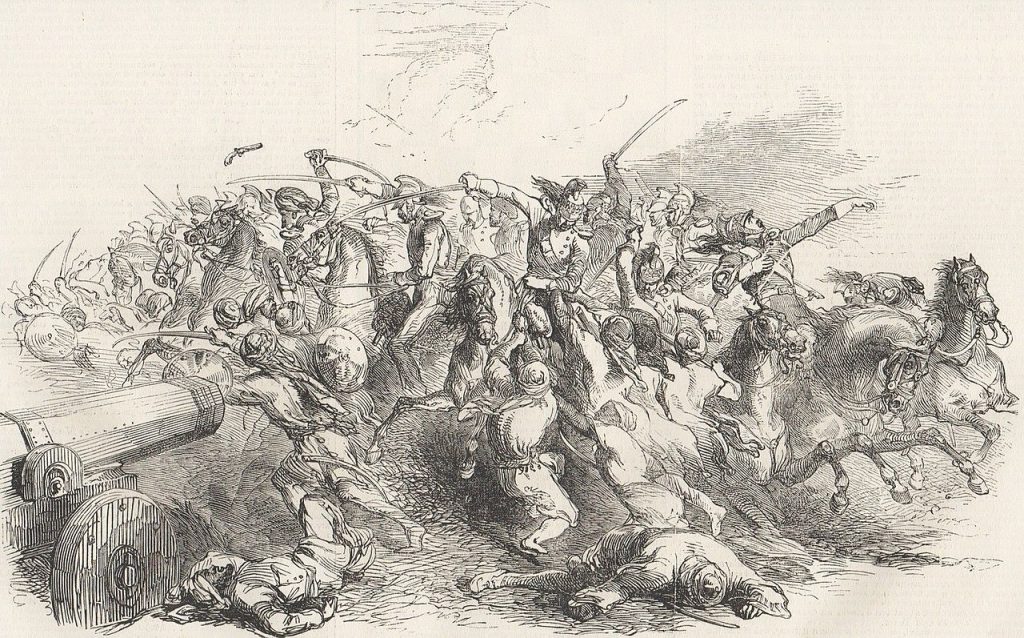
His loss, so early in the campaign, was deeply felt. The following General Order from Gough offers a picture of how highly regarded he was:
‘General Order to the Army of the Punjaub, Head Quarters, Camp Ramnuggur, 23rd November 1848
Aware of the general esteem and respect, in which Brigadier General Cureton was held by Officers of all Ranks, who have enjoyed an opportunity of serving under his command, or been associated with him, either on duty, or in private life, the Commander-in-Chief invites all so disposed to be in attendance to pay the last honours to this excellent Officer, who decease no Officer in the Army can more deeply lament than Lord Gough himself.’
Tragically, just a few weeks later, his youngest son Augustus Cureton of the 14th Light Dragoons was killed at Chillianwalla. Colonel Charles Thompson in 1895 recalled that ‘[Lieutenant Cureton] was seen to turn back and ride alone into the jungle, from which his horse shortly returned riderless, and I saw Cureton’s body brought into camp a fortnight later’.
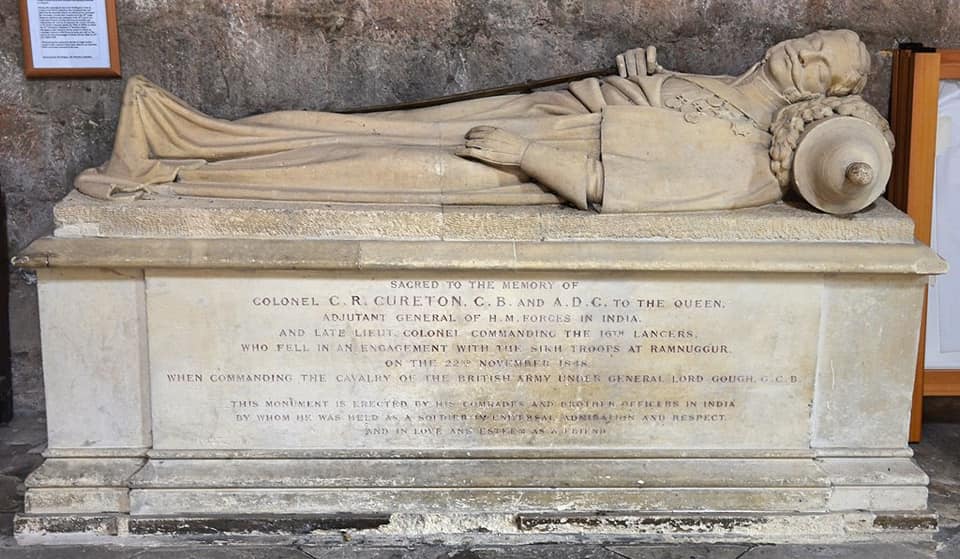
In 1855 an impressive memorial to Cureton was erected in St Mary’s Church, Shrewsbury. Sculpted by Richard Westmacott it was paid for by ‘comrades and brother officers in India’. According to the history of the church, the sword hilt was reportedly stolen in 1944 by an American soldier, leaving only an empty scabbard today.
Much more can be written on the distinguished career of Charles Robert Cureton, and there is still research to do, but a suitable eulogy to this ‘hero of Ramnuggur’ is found in the Naval and Military Gazette of 11 April 1846 which concluded:
‘No man in the Service is more popular – no man in any [regiment] more beloved, both by officers and men; and no man stands higher at the Horse Guards than Col. Cureton who fully deserves all honours that may be conferred upon him’
The Anniversary of the Battle is celebrated in The Warrant Officers’ and Sergeants’ Mess with a Ball or Dance for the Warrant Officers, Sergeants and guests. During the celebration, the Commanding Officer, the Regimental Sergeant Major and all Warrant Officers and Sergeants enact the Ceremony of the Horseshoe. The Warrant Officers’ and Sergeants’ form-up in a Horseshoe, in seniority order, with the Commanding Officer and Regimental Sergeant Major at the head. The Regimental Sergeant Major then recounts the key actions of the Battle of Ramnuggur. Following this, the junior Sergeant brings forward The Ramnuggur Cup. It is charged with champagne and passed from man to man, each proclaiming ‘The Heroes of Ramnuggur’ before drinking from the cup. Among the fallen remembered is Brigadier-General Charles Robert Cureton – a Hero of Ramnuggur.
